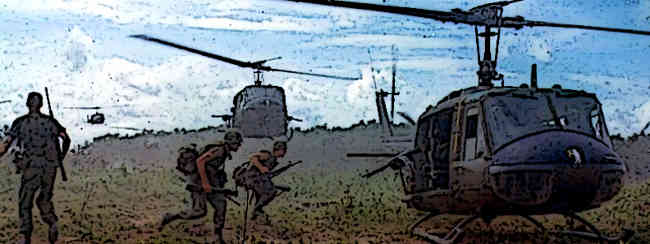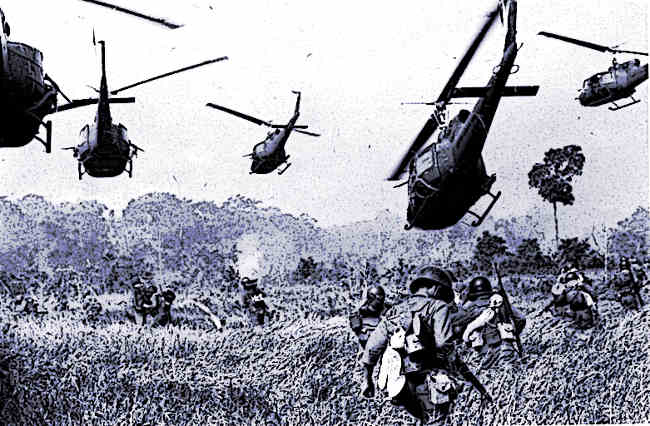Background
Soon after the end of World War II, the Cold War broke out. This was a series of proxy wars between United States and the Soviet Russia. One of these wars was the Vietnam War. The war was fought between North Vietnam, supported by the communist nations, and South Vietnam supported by anti-communist nations. It continued from 1955 to 1975, ending with a complete victory of the North Vietnamese forces.

Communism vs Capitalism
At the end of World War II, the United States and Soviet Union emerged as the two world powers. Both had radical differences in terms of ideology. United States championed capitalism whereas Soviet Union became the global leader of the communists.
Both countries attempted to expand their sphere of influence across the globe. This led to the Cold War, a protracted confrontation between the two nations involving several countries. The Vietnam War was a part of this conflict. And in this war, the communist forces were pitted against the anti-communist forces.
Events Leading to the War
Before World War II, Vietnam was a French colony. The communist forces of Vietnam were supported during World War II in a bid to defeat Japan. After the war, the communist groups began an insurgency against French rule. This conflict soon became a part of the Cold War.
By 1950, two separate governments in Vietnam had come into being. The one based in North Vietnam was recognized by Soviet Union, China and communist allies. The one based in South Vietnam was seen by United States and its western allies as the legitimate Vietnamese government.
American Involvement in the War
Initially, the French countered the communist insurgents. Until 1955, United States supported the French colonial government in fighting the war. However, French efforts failed and the French surrendered in 1954. After the surrender, Vietnam was partitioned and United States began actively supporting South Vietnamese government.
United States effectively took over the responsibility of supporting the economy and ensuring the security of South Vietnam. When a communist guerrilla group known as Viet Cong launched guerrilla war in South Vietnam, United States became more militarily involved.
Vietnam War and Kennedy
In 1960, John F. Kennedy became the U.S. President. Kennedy would go on to increase the American involvement in Vietnam. He initially offered more aid and assistance to the South Vietnamese government. At the same time, more and more American advisers were embedded at every level of the South Vietnamese government.
However, the guerrilla attacks of the Viet Cong only continued to increase. American-backed South Vietnamese government was marred by corruption and incompetence. It all reached a climax when Ngo Dinh Diem, the de facto leader of South Vietnam, was killed in a coup supported by the United States.
Gulf of Tonkin Incident
By 1964, United States was actively planning a direct involvement in the Vietnam War. A number of minor incidents took place at a conveniently correct time to give U.S. the excuse to do so. Among these were some unconfirmed attacks on U.S. ships along the North Vietnam’s cost.
The U.S. government blamed these on communist guerrillas. In the wake of the attacks, U.S. extensively bombed North Vietnam. By 1965, U.S. had also deployed more than 200,000 ground troops.
Richard Nixon and Vietnam War
From 1965 to 1969, United States launched an offensive against Viet Cong forces. Ultimately, the offensive was a failure as Viet Cong successfully continued its guerrilla warfare tactics. By 1969, Richard Nixon was the President and he began the policy to withdraw American troops from Vietnam.
The withdrawal continued as the morale of the American troops in Vietnam completely collapsed. In 1973, the U.S. Congress formally resolved an end to American involvement in the Vietnam War.
Domestic opposition to Vietnam War
During the presidency of Richard Nixon, an anti-war movement gained widespread momentum across the United States. Many war veterans who had been injured or disabled during combat participated in the movement. Others like Muhammad Ali, the boxer, refused the draft and took a principled stance in opposition to the Vietnam War.
As the movement gained momentum, it put a significant pressure on the U.S. government to conclude its involvement in the war.

American Failure and Exit
By 1973, the Senate had effectively prohibited the U.S. President from intervening in the Vietnam War. This marked the end of American involvement. Ultimately, most of the U.S. war objectives were not met. The United States could not stem the tide of communism or Viet Cong.
U.S. advisers and military failed to equip the South Vietnamese government so that it could combat the communist insurgents on its own. Domestically, the U.S. government failed to rally support for the war and faced increasingly greater resistance.
The Result of the War
Once United States left the Vietnam War in 1973, Viet Cong and North Vietnam were able to go on the offensive. They built up infrastructure, logistics and support. In 1975, the North Vietnamese forces launched a large-scale offensive. The South Vietnamese military quickly collapsed in the face of this offensive.
City after city and province after province was lost to the North Vietnamese forces. By April, 1975, the North Vietnamese forces were knocking on the doors of Saigon, the seat of the South Vietnamese government. The city fell after some resistance and the Viet Cong flag was raised over it.
Aftermath of Vietnam War
The Vietnam War ultimately resulted in the victory of the North Vietnam. Both parts of Vietnam were united as a result and Vietnam effectively became a communist ally. The war proved very deadly for civilians, Vietnamese soldiers and American troops. Somewhere between 1 million and 4 million Vietnamese died during the war.
Nearly 60,000 American troops also died in the conflict. Many war crimes were committed during the war. U.S. forces famously used napalm, a chemical substance that severely burned its victims. Other brutalities were committed by both sides during the war. War in Southeast Asia would continue even after Vietnam War ended. Subsequent wars would involve Cambodia and Laos, neighbors of Vietnam.